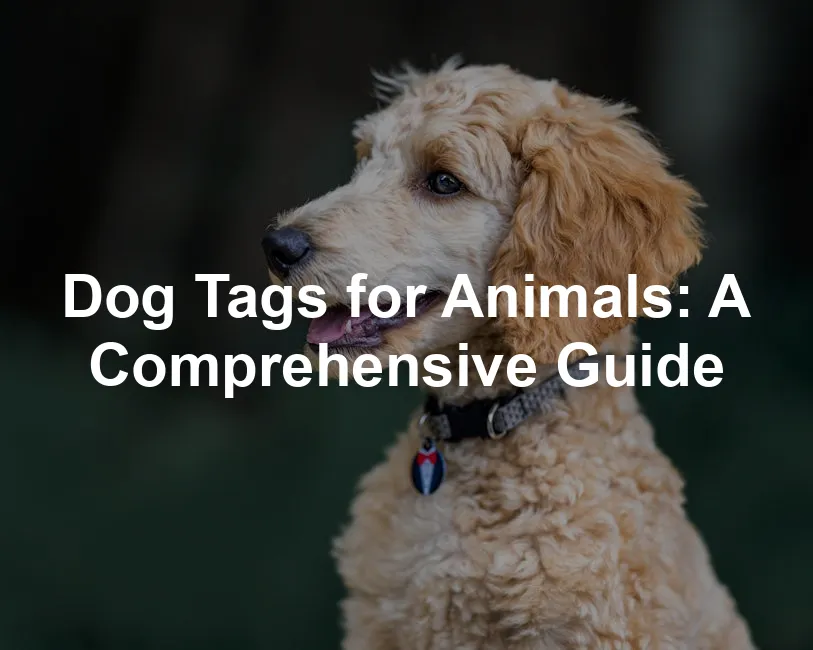Introduction
Dog tags are essential for pet safety. They help identify your furry friends if they get lost. This article will cover the types of dog tags, their benefits, and tips for choosing the right one.
Summary and Overview
This guide emphasizes the importance of pet identification. Dog tags can reunite lost pets with their owners quickly. We will discuss various materials, designs, and features of dog tags. The right tag can provide emotional comfort and enhance safety for your pets.
Types of Dog Tags
Material Options
When choosing a dog tag, material matters. Common options include stainless steel, aluminum, brass, and silicone.
Stainless steel is durable and resists wear. It’s ideal for active dogs. Check out this Stainless Steel Dog Tag for your adventurous pup! Aluminum is lightweight, making it suitable for smaller breeds. Brass tags offer a classic look but may tarnish over time. Silicone tags are flexible and quiet, perfect for noise-sensitive pets.
Consider your dog’s activity level when selecting a material. An active dog may benefit from the durability of stainless steel, while a quieter dog might prefer silicone. Each material has unique advantages, so choose wisely to ensure comfort and longevity.

Design Options
When it comes to dog tags, the design options are endless. You can choose from various shapes like bones, circles, and hearts. Each shape adds a unique flair to your pet’s collar. Color plays a big role too. Bright hues can make your dog’s tag stand out, while classic tones offer a subtle touch.
Personalization is where the magic happens. Many pet owners opt for custom engraving. Adding your pet’s name, your contact info, or a fun phrase makes the tag truly theirs. This personal touch can also reflect your pet’s personality. For example, a playful pup might sport a vibrant tag with a silly saying. You can get a Custom Engraved Dog Tag that captures their spirit perfectly!
Trends in dog tag designs are leaning towards minimalist and fun themes. More pet owners are choosing tags that express their pet’s character rather than just functionality. Unique designs like themed tags or those featuring favorite colors are gaining popularity. Consider a Themed Dog Tag to really make a statement!
If you’re looking for unique designs, check out websites like GoTags and DogIDs for inspiration. You’ll find a range of options to match your pet’s style!

Emotional Connection
Dog tags do more than identify your pet. They can showcase your furry friend’s unique personality. Imagine a tag that reflects your pet’s quirks or favorite activities. Customization options, like shapes and colors, make this possible.
You can engrave your pet’s name or a special phrase. This personal touch deepens your bond. When you look at the tag, it reminds you of shared moments. For example, my pup’s tag says, “Adventure Buddy.” Every time I see it, I remember our hiking trips together.
These tags express your love and care. They’re a way to celebrate your pet’s identity. A meaningful tag can even spark conversations with fellow pet owners. Have you ever shared a laugh over a funny tag? If you want to share those laughs, why not get a Heart-Shaped Dog Tag? It’s sure to be a conversation starter!
We’d love to hear your stories. What does your pet’s tag say? Share your experiences in the comments!

Maintenance and Care
Keeping your dog tags in top shape is crucial for their longevity. Regular maintenance helps keep the information visible and the tag looking good. Start with cleaning. For metal tags, use a soft cloth and mild soap. Avoid harsh chemicals, as they can damage the finish. Silicone tags can be washed with warm water and soap. Just be sure to rinse thoroughly.
Now, let’s talk about when to replace tags. If you notice scratches, fading, or if the engraving is hard to read, it’s time for a new tag. Tags made from softer materials may wear out faster, so keep an eye on them. Regular checks are essential. Make it a habit to inspect your pet’s tag monthly. This way, you ensure all details remain readable, and your furry friend stays safe.
To help you remember, consider setting reminders on your phone for regular tag checks. Keeping your pet’s information up to date can make a significant difference in case they go missing. After all, a small tag can lead to a big reunion! And while you’re checking those tags, why not invest in a Pet Identification Tag for extra security?

FAQs
What should be included on a dog tag?
When creating a dog tag, it’s crucial to include essential information. Start with your pet’s name. This helps others call your dog if they get lost. Next, add your contact information, such as your phone number. This is vital for quick reunions. You might also consider including your address or a note indicating that your pet is microchipped. If your pet has any medical needs, list those too. This information can be lifesaving in emergencies. Remember, a well-informed tag can make all the difference!
How do I attach a pet ID tag to a collar?
Attaching your pet ID tag to their collar is simple. You can use split rings or S-hooks for this task. Split rings are similar to key rings and are secure but may require some effort to open. S-hooks are easier to attach but can sometimes come loose. Choose the method that suits your comfort level. Whichever you choose, ensure the tag is firmly attached to prevent it from falling off during playtime!
Can I personalize a dog tag?
Absolutely! Personalization options for dog tags are vast. You can choose different shapes, colors, and engravings. Many pet owners opt for custom engravings featuring their pet’s name and fun phrases. Some even include their dog’s favorite activity or a quirky saying. This unique touch not only enhances identification but also reflects your pet’s personality. Don’t hesitate to get creative!
How often should I check my dog’s tag?
Regular checks on your dog’s tag are essential. Aim to inspect it at least once a month. Look for wear and tear, such as scratches or fading text. If the tag becomes difficult to read, it’s time for a replacement. Keeping your dog’s information up to date ensures quick action if they wander off. A little maintenance goes a long way in keeping your furry friend safe!
Are there alternatives to traditional dog tags?
Yes, there are several alternatives to traditional dog tags. Microchips are a popular option. They provide permanent identification, as they’re inserted under the skin and can be scanned by vets or shelters. Other options include QR code tags, which link to your pet’s online profile with all necessary information. While not a replacement for tags, these alternatives can enhance your pet’s safety and identification. Consider what works best for you and your pet!
Please let us know what you think about our content by leaving a comment down below!
Thank you for reading till here 🙂
For a detailed look at the history, types, and customization of dog tags, check out this comprehensive guide to dog tags.
All images from Pexels





